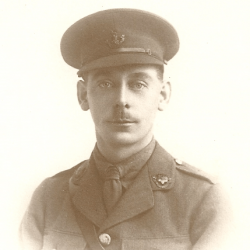John Reginald Tommis was born in Wilmslow on July 14, 1892 the oldest son of Richard and Annie Tommis (née Mills). By 1911 John was working as a travelling salesman for a rubber boot company and living with his parents and his younger brother, George Harold Tommis, in Wilmslow within walking distance of the Wilmslow Preparatory School where his father was the headmaster.
Shortly after the outbreak of war, on October 6, 1914, he joined the 7th Battalion, Manchester Regiment as a Private (#2687). 9 months later, on July 3, 1915, he was discharged from Crowborough to a commission as a Second Lieutenant in the 9th Battalion Manchester Regiment (Territorial Force) effective July 21, 1915. After 3 months training, on October 13, 1915, he embarked on His Majesty’s Transport Ship Scotian at Devonport for Gallipoli with 10 other Officers, arriving at Mudros on October 24th and joined the Battalion on Cape Helles on October 26, 1915.
He survived Gallipoli unscathed and sailed with the Battalion to Egypt, arriving on January 18, 1916. On July 23, 1916 he left for 35 days home leave in the UK where he married Annie Wilson. He rejoined the Battalion in Egypt in late August and on September 2nd he attended a course of instruction. He sailed with the Battalion to France, arriving March 11, 1917 and was almost immediately attached to the 42nd Division Signals Company where he remained for two months. From this point, he was effectively a Signals Officer attached the Royal Engineers and remained this way until the end of the war. He rejoined the Battalion on May 15 but two weeks later went sick to hospital where he remained for almost a month. Upon being discharged from hospital he was temporarily attached to the 210th Brigade of the Royal Field Artillery and shortly thereafter was promoted to Lieutenant on July 1, 1917. He remained with the R.F.A. until February 17, 1918 when he transferred to the 6th Battalion Manchester Regiment and was struck off the strength of the Battalion.
On April 6, 1918 he was severely wounded by a machine gun bullet to the chest from an aeroplane when repairing telephone lines on the Somme. The entrance wound entering the back of the top of his right shoulder. He coughed up blood for 4 days but there was no evidence of haemothorax, (a collection of blood within the pleural cavity which is potentially life-threatening). He was treated in Hospital in France until sufficiently fit to travel, at which point he was medically evacuated to England. He was medically assessed at the 4th London General Hospital, Denmark Hill on May 23, 1918, given an overly optimistic diagnosis and granted 2 months leave. He was however paid a wound gratuity of £83 6s 8d on June 14, 1918.
And so began a series of monthly medical assessments, at Blackpool, that each pronounced him permanently unfit for General Service and an expectation of reaching a fitness level of ‘C1’ within six months. At his August assessment he was pronounced to have reached fitness level ‘C2’ and subsequently awarded another gratuity of £166 13s 4d. He was again pronounced to have reached fitness level ‘C2′ on September 23, 1918 and was promptly assigned to the College of Technology, Manchester University under the temporary employment of the Officers’ University and Technical Committee (O.U.T.C). The OUTC was a short-lived government programme, initiated by the Minstry of Munitions and run by the Ministry of Labour, designed to provide university training for disabled officers in order to better equip them for post war employment in government and commerce.
Lt. Tommis was called to London for yet another medical assessment on July 1, 1919. He was awarded a one year £50 pension gratuity, on account of his injuries, granted for the period April 6, 1919 to April 5, 1920. He was then instructed to report to Prees Heath where he was demobilised on July 9, 1919.
He was still not a well man and in November 1919 he started coughing up blood again, as he had done when initially wounded, and he subsequently underwent an operation to remove the machine gun bullet that up until this time was still lodged in his upper chest. The operation was successful, leaving a 7 inch scar, and on February 4, 1920 he was medically assessed again, this time in Leeds where he and his wife were now living. The report was not entirely encouraging:
“States that he had haemoptysis [coughing up blood] 3 months ago. The bullet was then removed from the chest 10 weeks ago. Now has cough without blood. Feels weak and cannot exert himself. Small scar of entry at base of right acromion good scar, long fresh operation scar 7″ long across right chest just above nipple. A little superclavicular dulness, cavernous breathing top of right chest and lower neck. Evidence of old pneumothorax [collapsed lung] not yet completely absorbed. Looks ill.”
He was awarded another one year £50 pension gratuity, on account of his injuries, granted for the period April 6, 1920 to April 5, 1921 and informed that the pension could be awarded permanently until it had been paid annually for 5 years.
He resigned his commission on February 22, 1921 retaining the rank of Lieutenant. He stayed in Leeds working again as a travelling salesman. Lt. John Reginald Tommis died on June 10, 1965. He was 63 years old.

